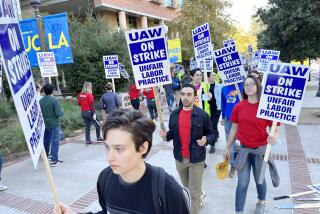SPECIAL REPORT * Despite initial hopes for savings, the overhauled L.A. Unified will be paying higher salaries to more people, raising the question of whether the organization is . . .
A year of reform and reorganization at the Los Angeles Unified School District is significantly raising the salaries of top executives as well as increasing the number of people who can earn in the six-figure range, a Times analysis has found.
At the same time, a gradual mushrooming of jobs in the 11 new subdistricts has apparently wiped out initial projections that the reorganization would trim hundreds of jobs. District officials now say they expect the total number of administrative positions to remain about 3,500.
For new Supt. Roy Romer and the four top department heads, salaries are up 30% to 40%. Romer is expected to be paid more than $250,000, with benefits, which would make him the highest paid public official in Los Angeles County. Leaders of the legal, financial, facilities and data operations will make $190,000 or more.
While reducing staff in the district’s central office, the reorganization plan of interim Supt. Ramon C. Cortines will create dozens of new positions in the new subdistrict offices, many with salary ranges that top $100,000, district records show.
As a result, the new organization charts show 210 such positions paying more than six figures, about 15% more than the current 183. Seventeen spots boast salaries of $150,000 or more, up from the current five.
“Some of the new leadership of the district and accompanying management gurus might think we are, as they say, flattening the organization, but the evidence thus far looks like we’re fattening the organization,” said Board of Education member David Tokofsky.
But the salary creep makes sense to those who believe the school district should function more like a business.
“Typically, when you . . . decentralize management responsibilities, you create positions that are more highly valued from a pay point of view than you had before,” said Ed Lawler, a distinguished professor at the Marshall School of Business at USC. “Hopefully you are moving more decision making into those units. I’m not surprised they’ve created a number of higher paying jobs.”
More troublesome, Lawler said, is the potential for job proliferation if too many old central-office positions are re-created in the new subdistricts.
“If you’re not careful, you end up with a bigger total payroll, rather than a smaller payroll,” he said. “You can not only end up with higher pay, you can end up with more people over time.”
The reorganization is heading in that direction. When the plan was unveiled in March, Cortines projected that each of the 11 subdistrict offices would have 70 to 90 employees. Now, only two weeks before the reorganization goes into effect, officials still can’t say exactly how many jobs there will be at the district offices, but expect the average will be about 110.
More than a third of the six-figure jobs will be in the new districts. From the outset, each district was assigned a superintendent with a maximum annual salary of $150,000 plus a business manager and five educational directors with salary ranges topping $100,000.
Since the announcement, several new positions have been added at the subdistricts, including one arts coordinator and 19 facilities officials. Some of those jobs are new and some are being transferred from the central office.
Overall, the difference is enough to entirely wipe out the reduction of about 300 positions promised by Cortines and district officials when they unveiled the plan March 20.
“I think we’re close to being a zero sum game,” said Anne Valenzuela-Smith, who is in charge of the implementation.
“Decentralization is not generally a cost-cutting strategy,” Valenzuela-Smith said. “It was not conceived as a cost savings or a cost-adding thing. It was, ‘What do we need to do to make ourselves successful?’ ”
Nonetheless, district officials originally said the reorganization would save $46 million. The staff changes since then have trimmed the savings to about $30 million, Valenzuela-Smith said.
Tokofsky said that he doubts there will be any savings, and that in fact the reorganization may cost the district more.
The combined creep of salaries and jobs is troubling to district critics such as David Barulich, who for two years represented the Howard Jarvis Taxpayers Assn. on the oversight committee for school bond projects.
“Increased salaries are fine,” Barulich said “But to justify those higher salaries, they’ve got to lay some people off. If they’re not, I think the taxpayers are going to get a raw deal.”
Figures Change From Day to Day
School officials said they won’t be able to tally the final net change in positions and savings until after the reorganization is fully implemented, partly because the numbers continue to change from day to day as some jobs are added and others deleted.
For example, the recent announcement that Chief Operating Officer Howard Miller would leave the district June 30 created an opening that may not be filled. Romer said he will do without that position for now, but could change his mind.
Romer does not have a teaching certificate, precipitating a debate over whether the No. 2 spot should be reserved for an educator. Currently, the highest instructional position in the organization chart is an associate superintendent’s position, well down the salary chain.
More confusion flows from the failure of the Board of Education to resolve the cases of employees blamed for failing to address the environmental problems at the now-abandoned Belmont Learning Complex. Two took buyouts and a third quit the district. But six remain on administrative leave. The district’s personnel office has to hold their jobs open while other employees, or in some cases, highly paid contractors, perform their work.
Since taking over last fall, Miller and Cortines have relied on consultants as part of an effort to invigorate the district’s teacher-dominated bureaucracy with outside talent. Those outsiders also make it difficult to calculate employee costs.
Atop the list of highly paid contractors is interim Facilities Executive Robert Buxbaum, who recently negotiated a monthly salary of $37,500 through October. That works out to $450,000 per year.
Like Buxbaum, acting General Counsel Richard H. Sheehan and Real Estate Director Scott Graham were brought in to fill vacancies. Miller said he considered the potential outcry over compensation a necessary risk in their campaign to change the district culture.
“If you pay $50,000 more for a chief financial officer, everybody screams,” he said. “If you spend $1 million on legal losses because the chief financial officer was inadequate, that’s business as usual.”
Their high pay, reflecting the fierce competition for top-flight executives, set the stage for a general increase in compensation. Buxbaum’s job, for example, has been advertised at $190,000, a 40% increase over the corresponding position before the reorganization.
Sheehan’s pay is not yet on record because he was retained on an hourly rate and has not yet filed any bills, although he has been on the job about eight months. He plans to turn the post over to a permanent employee soon and said the salary will be set at more than $200,000 a year.
Such increases are putting many of the district’s upper management on a par with Los Angeles County’s most highly paid administrators.
Romer will undoubtedly surpass County Health Director Mark Finucane, whose $231,790 annual salary is currently tops in the county government, and will far exceed the $202,802 paid to the county’s chief administrator, David Janssen, who oversees an organization with nearly twice the district’s $8.4-billion budget. Similarly, the new general counsel will greatly exceed the county counsel’s salary of $165,028.
“Hurray for them for getting something closer to what they deserve,” said William Ouchi, vice dean of the Anderson Graduate School of Management at UCLA.
Smaller Districts in U.S. Pay More
Ouchi and others who believe the management is still underpaid cite the board’s embarrassing quandary when many of the country’s most sought-after superintendents thumbed their noses at the job despite the $250,000 salary.
“Districts around the country are paying $250,000 with 100,000 students or less,” said Pittsburgh schools Supt. John W. Thompson. “That’s almost an insult for the amount of responsibility they have.”
Indeed, Houston’s Supt. Rod Paige was one of the board’s top candidates until his own district got him to stay there with a 26% raise to $275,000 a year.
Public agencies cannot compete with the private sector in salaries for top executives, said Lawler, the USC professor. But they must be willing to pay enough that a strong candidate can take on a job without making a huge sacrifice. Plenty of executives are attracted to public service but aren’t willing to give up their lifestyles, he said.
“What you like to do is compete for those who are able to make some sacrifice and are excited about whatever the mission is,” Lawler said. “It’s hard to convince the public that it’s a good investment. But it can be a good investment.”
(BEGIN TEXT OF INFOBOX / INFOGRAPHIC)
Salary Increases
Top salaries in the Los Angeles Unified School District have escalated in a year of reform and reorganization. Below, salaries for various positions before reforms began and what those jobs will pay when the reorganization goes into effect July 1.
*--*
Position Old Salary New Salary Superintendent $192,454 $250,000+ Chief operating officer* $150,287 $200,000+ Deputy superintendents $150,287 Eliminated General counsel $141,886 $200,000+ Chief information officer $144,794 $190,000 Chief financial officer $144,794 $190,000 Chief facilities executive $144,794 $190,000 Subdistrict superintendents New $150,000**
*--*
Before reorganization, five people were paid more than $150,000.
After reorganization, 17 people will be in that category.
*--*
Other Positions Old New $140,000/$149,999 2 4 $130,000/$139,999 1 2 $120,000/$129,999 7 11 $110,000/$119,999 13 8 $100,000/$109,999 151 168
*--*
*Previously chief administrative officer. To be vacated July 1. Could be eliminated, reconfigured or filled.
**Salary quoted is top of the range for subdistrict superintendents.
Source: Los Angeles Unified School District
More to Read
Start your day right
Sign up for Essential California for news, features and recommendations from the L.A. Times and beyond in your inbox six days a week.
You may occasionally receive promotional content from the Los Angeles Times.







